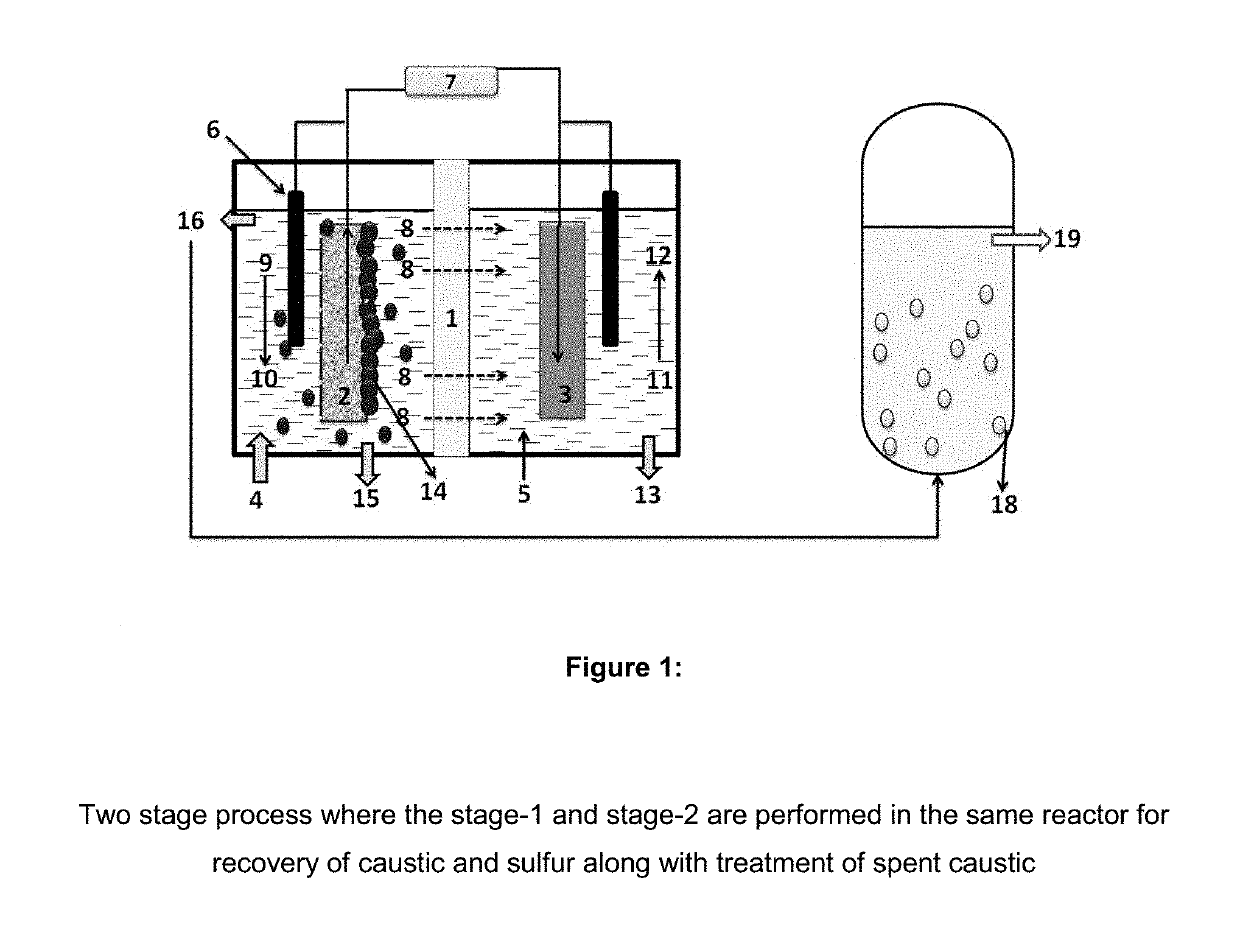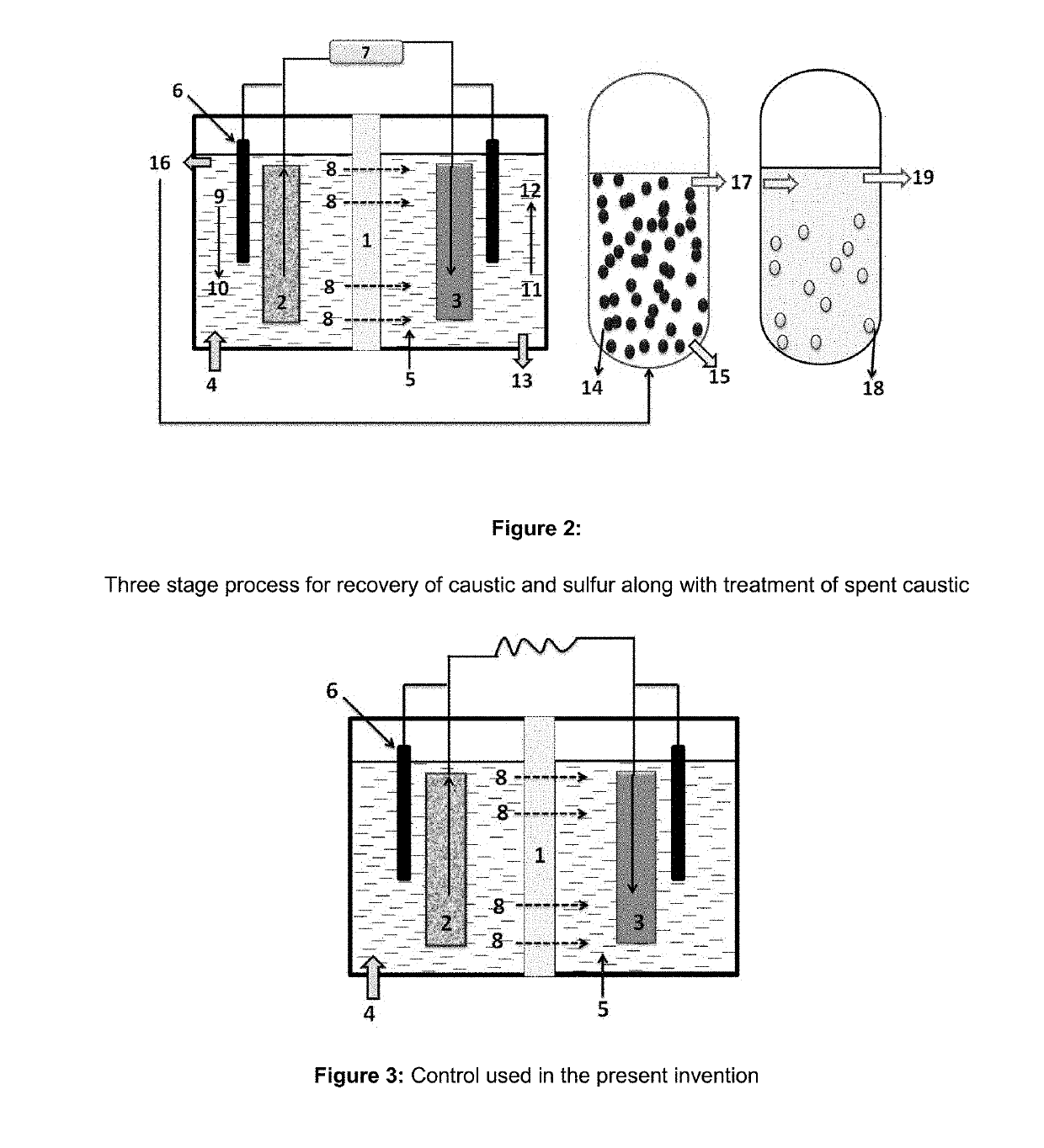Treatment and recovery of caustic from spent caustic through bioelectrochemical process
a bioelectrochemical and caustic technology, applied in the direction of electrodes, water treatment parameter control, water/sludge/sewage treatment, etc., can solve the problems of affecting the effect of the process, the immobilization of bacteria in the process is a major drawback, and the caustic is the most difficult of all industrial waste to dispose of properly
- Summary
- Abstract
- Description
- Claims
- Application Information
AI Technical Summary
Benefits of technology
Problems solved by technology
Method used
Image
Examples
example 1
of Caustic from the Spent Caustic
[0099]The recovery of caustic from spent caustic is done in stage-1 process where, one of the two chambers is inserted with graphite rod wrapped with ACC and fed with spent caustic, while the counter chamber is inserted with graphite electrode wrapped with SS and fed with distilled water. The electrodes were connected to potentiostat and voltage of +2V against Ag / AgCl reference electrode was applied to the electrode in counter chamber and pH of the counter chamber was monitored at regular time intervals. The current generation from the system started increasing with time and in 2 h of operation, it reached 15±0.5 A / m2, which sustained afterwards at more or less similar value till 12 h of operation. Within 12 h, the pH of the counter chamber reached to 12.67 and the pH of working chamber reached 12.89 indicating the caustic recovery at the counter chamber. Immediately, the content from counter chamber was replaced with fresh distilled water and the ap...
example 2
ous Recovery of Caustic and Sulfur
[0100]The recovery of caustic along with sulfur was attempted by adding selective sulfide oxidizing bacteria to the spent caustic at working chamber of stage-1 bioreactor. One of the two chambers is inserted with graphite rod wrapped with ACC and fed with spent caustic, while the counter chamber is inserted with graphite electrode wrapped with SS and fed with distilled water. Working chamber was inoculated with selectively enriched sulfide oxidizing bacteria (10% v / v). The electrodes were connected to potentiostat and voltage of electrode in working chamber was maintained around −0.3 V (vs Ag / AgCl) by regulating the potential of electrode in counter chamber against Ag / AgCl reference electrode. The applied potential of electrode in counter chamber was adjusted to +1 V initially to maintain the working chamber at −0.3 V but within 1 h, this has come down to +0.8 V due to the start up of biocatalyst function. This was sustained till the end of operatio...
example 3
l Conversion of Sulfides to Sulfur
[0101]The spent caustic treated in stage-1 was fed in a CSTR with air bubbling system reactor and to the reactor nutrient system containing K2HPO4 (4 g / l), KH2PO4 (4 g / l), MgCl2 (0.2 g / l), 0.5 g / l of trace elements, sodium carbonate (2 g / l), yeast extract (5 g / l), sodium nitrate (4 g / l), citrate (5-10 g / l), sorbitol ester (5 ppm), Oleic acid (100 ppm), pantothenic acid (20 ppm), thiamine (25 ppm) was added. The reactor is inoculated with Thiobacillus sp. The oxygen concentration of the reactor was maintained to 5 mg / ml initially for 2 hr followed 2 mg / ml level for next two hours. The stirring of the reactor was adjusted at 50 rpm. To prevent the release of volatile compounds from the system, gas phases are continuously recycled. The recycled gas is first passed to a condenser (maintained at 5 degree Celsius) to recover the volatile compounds and metabolites. An control without bacteria was also run under similar conditions. Various sulphur species w...
PUM
| Property | Measurement | Unit |
|---|---|---|
| pH | aaaaa | aaaaa |
| current densities | aaaaa | aaaaa |
| temperature | aaaaa | aaaaa |
Abstract
Description
Claims
Application Information
 Login to View More
Login to View More - R&D
- Intellectual Property
- Life Sciences
- Materials
- Tech Scout
- Unparalleled Data Quality
- Higher Quality Content
- 60% Fewer Hallucinations
Browse by: Latest US Patents, China's latest patents, Technical Efficacy Thesaurus, Application Domain, Technology Topic, Popular Technical Reports.
© 2025 PatSnap. All rights reserved.Legal|Privacy policy|Modern Slavery Act Transparency Statement|Sitemap|About US| Contact US: help@patsnap.com


